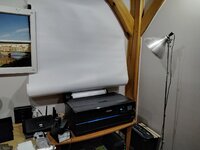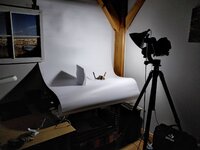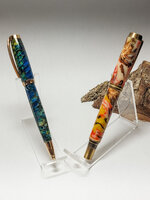I'm relatively new to pen making. I started last year, but only did a little bit before health and lathe problems put me out of commission until about May this year. I'm going to try to start selling the pens I make, and am looking to produce very professional quality pens and pen photos.
I've been doing photography for years, and have a new Canon EOS R5 that I picked up for bird, wildlife, macro and landscape photography. So I know photography in general very well. I've never really done much indoors photography, though, and have never really worked with artificial lighting or flash much or any of that.
I'm curious what people have found as the best setups. I don't necessarily just want a pen on a clear stand...I think some of the best photos I see, at least the ones I like, seem to have nice background and base materials. They also seem to have really great lighting, with soft shading, but still enough specular highlights to show of the pen's shine.
I'm curious what base/background materials people have found work best for their scenes. Also curious how people set up their lighting to get the best shots, at low ISOs and high frame rates, but without blowing out the highlights too much.
I've been doing photography for years, and have a new Canon EOS R5 that I picked up for bird, wildlife, macro and landscape photography. So I know photography in general very well. I've never really done much indoors photography, though, and have never really worked with artificial lighting or flash much or any of that.
I'm curious what people have found as the best setups. I don't necessarily just want a pen on a clear stand...I think some of the best photos I see, at least the ones I like, seem to have nice background and base materials. They also seem to have really great lighting, with soft shading, but still enough specular highlights to show of the pen's shine.
I'm curious what base/background materials people have found work best for their scenes. Also curious how people set up their lighting to get the best shots, at low ISOs and high frame rates, but without blowing out the highlights too much.




